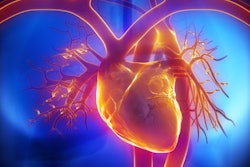
Women with coronary artery disease are much more likely to have frequent chest pain than men, despite having less extensive disease on coronary CT angiography (CCTA) and less severe ischemia on stress imaging, according to a study.
The International Study of Comparative Health Effectiveness with Medical and Invasive Approaches (ISCHEMIA) trial is an ongoing investigation into best management strategies for patients with stable coronary artery disease confirmed with CCTA.
For the current study, researchers from more than a dozen U.S. institutions examined a subcohort of ISCHEMIA trial participants who had abnormal findings indicating moderate to severe ischemia on a stress nuclear test, stress echocardiogram, or stress cardiac MRI exam. Their study is one of the various virtual presentations that the American College of Cardiology will host from March 28-30, in lieu of the organization's in-person meeting in Chicago, which has been canceled.
Among 5,179 individuals, women had a 38% greater likelihood of experiencing frequent chest pain than men, despite having less extensive stenosis and ischemia based on CCTA scans and stress testing. The outcome remained the same even after taking into account other factors, including age, race, medication use, smoking, blood pressure, and overall heart function.
"Women are having more chest pain even though they have less plaque on imaging. ... Even when women have very abnormal stress tests -- more characteristic of what we think of as typical 'male type' coronary heart disease -- they have less extensive atherosclerosis and yet they are still having more symptoms as compared with men," said lead author Dr. Harmony Reynolds, director of the Sarah Ross Soter Center for Women's Cardiovascular Disease at NYU Langone Health, in a statement from the ACC.
The researchers used a questionnaire to determine how often the individuals felt chest pain and to what extent it affected their daily activities. They found that a significantly greater percentage of women experienced chest pain on a daily, weekly, and monthly basis, compared with men (p < 0.001). Yet a much smaller percentage of women had severe ischemia and significant stenosis in three or more coronary arteries, compared with men (p = 0.006; p < 0.001).
"These findings suggest that just because there may not be as much plaque, many women may have chest pain that limits their daily activities, and we have medicines that can improve chest pain from heart disease," Reynolds said.
The results also indicate inherent differences in the way plaque forms as well as the relationships between chest pain, atherosclerosis, and ischemia in men versus women, she noted. These differences may have implications for the testing and treatment of individuals with suspected coronary artery disease.
"When it comes to the burden of chest pain in these women, is it because the activation of nerve endings in a relatively smaller amount of heart muscle will raise the red flag in a woman's brain differently, or is it because there are other factors going on in women, like small vessel disease, that we aren't assessing with the tests that we are using?" Reynolds said.
These questions underscore the need for continued research that considers a dual focus for the prevention and management of cardiovascular diseases and events, she said.




















